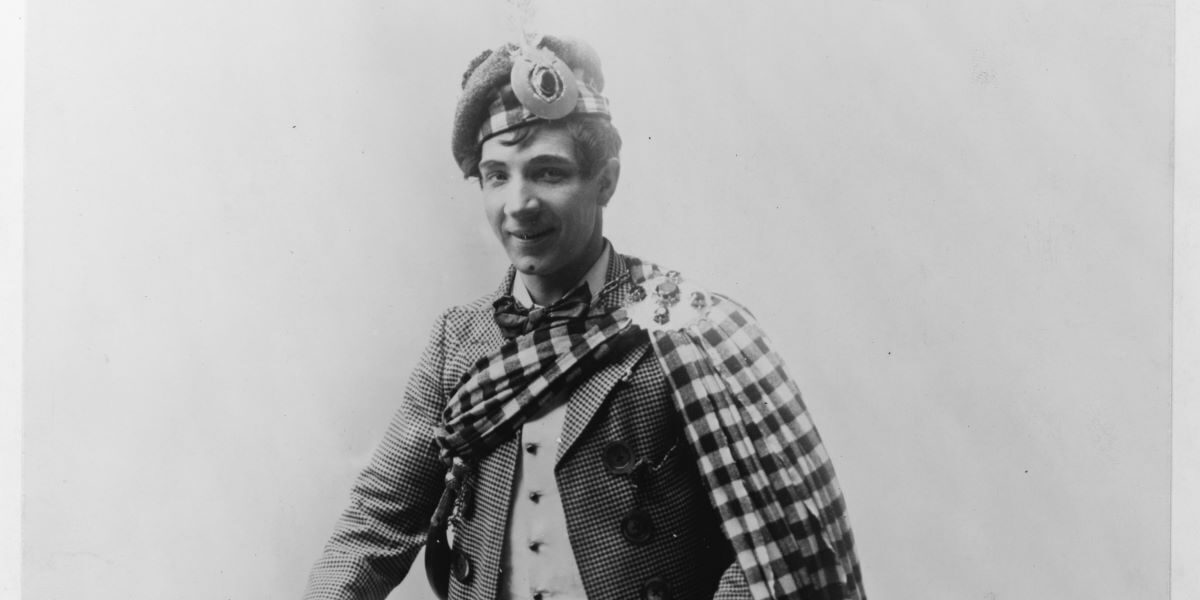One of the latest conservation projects in the studio was the treatment of two jackets owned by Harry Lauder. Read on to learn about the history of the objects, their condition issues and how the costumes were preserved for future display.
Who was Harry Lauder?
Harry Lauder was an early 20th century music hall performer. Lauder achieved international success, and by 1911 he was the highest paid performer in the world. He was known for spreading an over-the-top image of Scotland, particularly through his costumes. He often wore exaggerated versions of traditional Highland dress such as kilts, plaids, sporrans, and tam o’shanters, all of which featured lots of tartan. The two objects that were treated by Rossi Conservation were no exception.

Objects
The two objects were both kilt jackets owned by Low Parks Museum in Hamilton. The black jacket was worn while Lauder performed one of his most famous songs, Roamin’ in the Gloamin’, and the brown one was his costume for the song Tobermory. Not much is known about the creation of the costumes. Looking at the construction of the jackets, it appears that the costumer purchased ordinary kilt jackets and decorated them to make them even more “Scottish”.

Before Conservation Treatment
Before treatment began, the condition of both jackets was documented. Both jackets had silk tartan ribbons, which were in poor shape. Many of the vertical warp threads had been lost, leaving the ribbons with loose threads and little structure to hold them together. Some of the ribbons were in immediate danger of being lost. Much of this damage was likely caused by their heavy use as theatre costumes and exacerbated by exposure to light.

Other than the ribbons, the Tobermory jacket was in good condition. However, the lining of the Roamin’ jacket had numerous tears and was too weak to be put on display. Jacket linings are often strained during use, so it’s unsurprising that the lining had torn in multiple places.

Conservation Work
The ribbons on both jackets were too weak for extensive stitching. Additionally, the ribbons on the Roamin’ jacket would be visible on both sides, and the ribbons on the Tobermory jacket were only accessible on their faces. Therefore, an adhesive treatment was chosen to return strength to the ribbons, organise the loose threads, and infill areas of loss. Three different shades of silk crepeline were dyed to match the ribbons. The crepeline was then brushed with conservation grade adhesives, making the fabric tacky on one side. Finally, the crepeline overlay was attached with a few lines of stitching and then the adhesive was activated with a low temperature heated spatula. After treatment, the ribbons are much stronger, but have maintained their flexibility.

The lining of the Roamin’ jacket also required a significant amount of conservation work. Patches of black silk habotai were inserted between the lining and the interfacing of the jacket and stitched in place. These patches supported the weakened areas, made the lining appear more visually complete, and made the object safe for display on a mannequin.

After Conservation Treatment
Now that the conservation treatments have been completed, both jackets are in stable condition and can be safely exhibited on mannequins in the future. Below are a few comparisons of the jackets before and after conservation. If you are interested in having a textile of your own conserved, please contact Rossi Conservation here.






